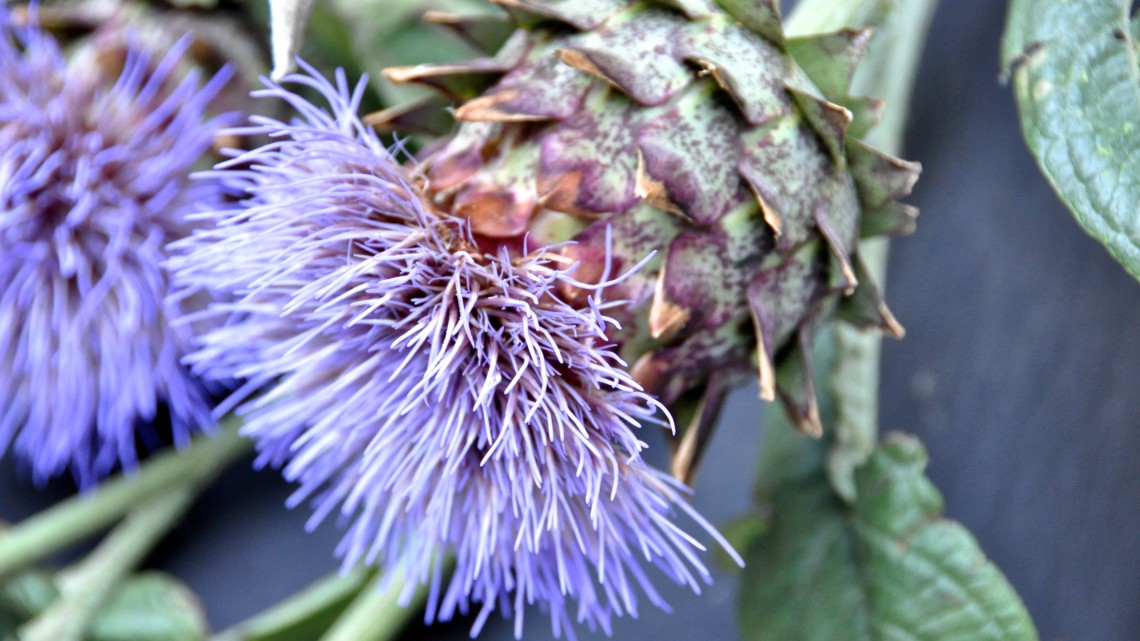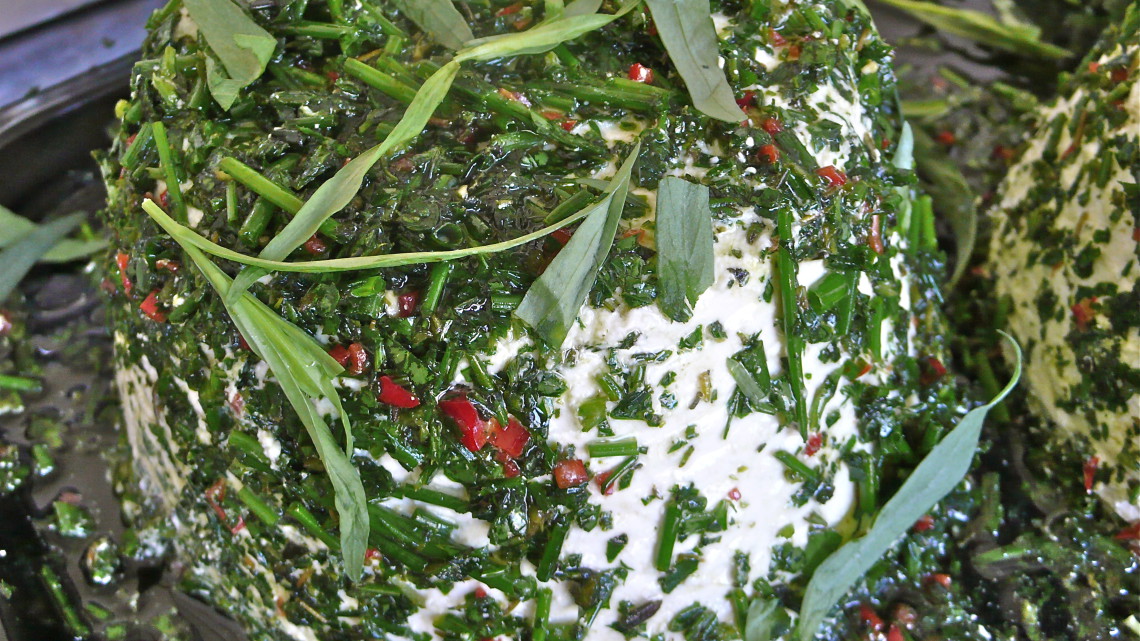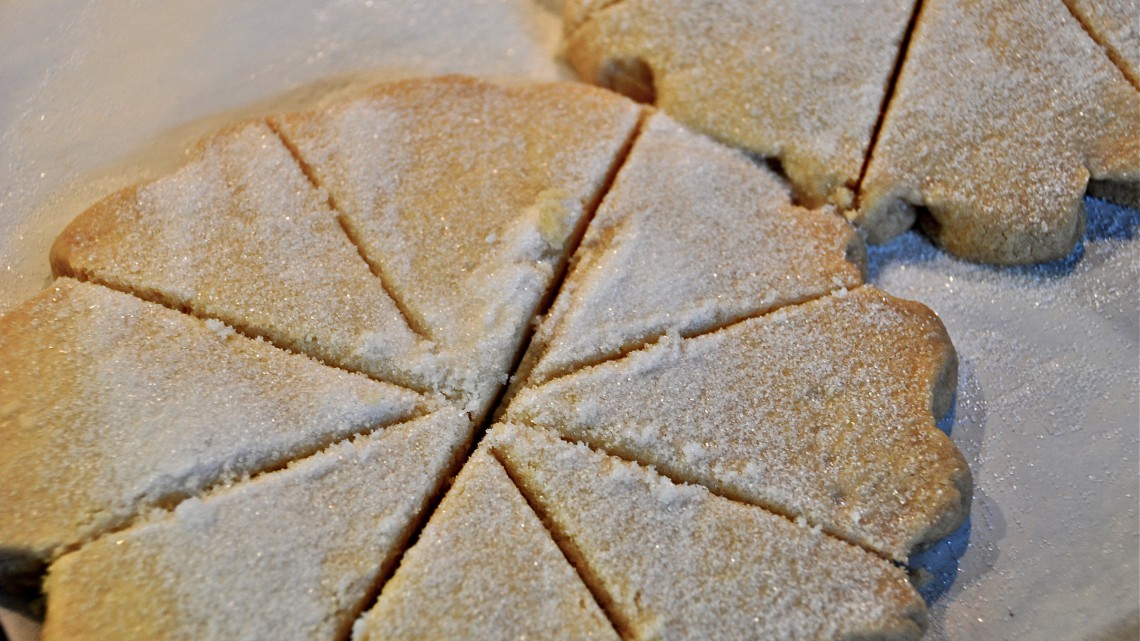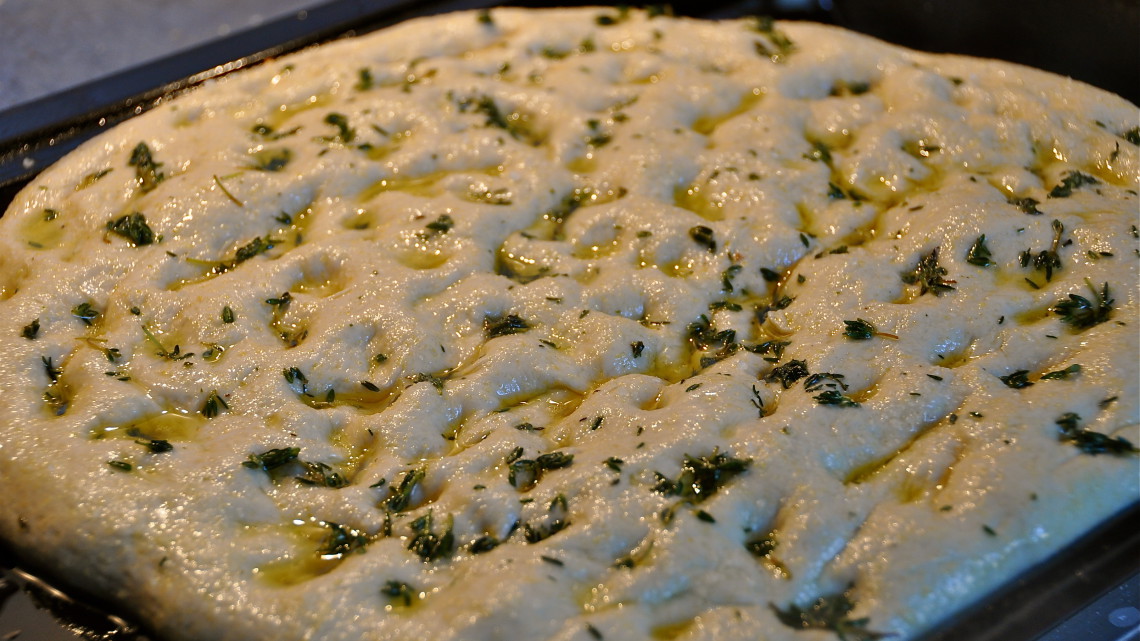Fried Artichokes
Ingredients
4 artichokes
sunflower oil for deep fat for frying
5 salted anchovies
200 ml olive oil
freshly ground black pepper and salt
Method
Heat the sunflower oil in a large pot or if you have a deep fat fryer, use that till the oil has reached 180° C.
Trim the hard outer leaves away from the artichoke and shave off the tough layer of the stalk. Fry the whole artichokes for about 10-15 minutes. Once golden brown and tender, remove from the oil and drain. Cut the artichokes in half, remove the hay from the centre and then press them between two plates.
Heat the olive oil in a small pot over a low heat. Fillet the anchovies, if necessary and rinse well under cold water to remove any excess salt.
When the the olive oil is warm add the anchovies and soften using the back of a fork until the anchovies break up, season well with salt and pepper.
Before serving, quickly refry the artichokes in the deep fat to reheat. Drain the artichokes on kitchen paper, season with salt and pepper and serve the anchovy sauce separately.
We, the Amsterdam Flavours chefs, hope you enjoy this recipe as much as we do. If you have any questions on how to prepare it or just want to send us your feedback, you can reach us here Contact Amsterdam Flavours
Roasted Pork
Serves 8
Ingredients
3 kg pork loin, bone in
sea salt
1 tablespoon freshly chopped rosemary
2 teaspoons fennel seeds
5 cloves garlic
8 tablespoons balsamic vinegar
4 bay leaves
2 tablespoons olive oil
some pork bones, chopped (ask your butcher for this)
4 sticks celery, roughly chopped
1 carrot, roughly chopped
2 onions, roughly chopped
Method
Using a sharp knife or stanley blade, score the skin of the pork in a criss-cross fashion, If you have a good butcher, you can ask him to do this for you. Rub some sea salt and half the chopped rosemary into the scored skin, pushing as much as you can into the cuts. In a pestle and mortar, pound the fennel seeds, garlic cloves and remaining rosemary into a puree and rub onto the meat. If you rub it on to the skin, it will burn during the cooking. Place the pork loin into a large roasting tray with the balsamic vinegar, bay leaves and olive oil and allow to marinate for at least and hour.
In the meantime, preheat the oven to its highest setting and brown the pork bones. Rub a little more salt into the pork skin to ensure it crisps up in the oven. Lay the pork directly on the oven rack in the top part of the oven. Add the browned bones and vegetables to the balsamic marinade, add 600 ml water to the roasting dish and place the tray in the oven, directly under the pork. As the pork roasts, all the juices will drip down into the roasting dish, which will be used later to make the sauce.
The pork will take about an hour to cook. After about 20 minutes, reduce the oven temperature to 220° C. When the pork is done, remove from the oven and lay on a piece of aluminium foil, to catch all the juices. Allow the meat to rest for at least 15 minutes.
While the pork is resting, finish the sauce. Place the bones, the liquid and the vegetables in a pot. Add a little water to the roasting tray, set over a medium heat on the stove. Scrape all the sticky goodness off the bottom and bring to the boil. Add to the pot with all the other ingredients. Bring this to the boil, skimming off any impurities which may rise to the surface. Pour through a sieve, discarding the bones and vegetables. Pour the sauce back into the pot, boil to reduce slightly and add salt of necessary. Serve the pork, sliced, with the sauce, some roast potatoes and green seasonal veg.
We, the Amsterdam Flavours chefs, hope you enjoy this recipe as much as we do. If you have any questions on how to prepare it or just want to send us your feedback, you can reach us here Contact Amsterdam Flavours
Roast Duck Breast with Red Wine and Citrus
SERVES 4
Ingredients
4 duck breasts, about 150g to 200g each
rosemary sprigs or leaves
FOR THE SAUCE
1 small onion, thinly sliced
1 tablespoon olive oil
250ml dry red wine
250ml chicken stock
1 tablespoon chopped sage leaves
grated zest and juice of an orange
grated zest and juice of a lemon
1 tablespoon honey
salt and freshly ground black pepper
TO GARNISH
wedges of orange and lemon
Rocket or watercress
TO SERVE
roasted potato chunks
Method
Preheat the oven to 200° C. Score the fat of the duck with a sharp knife in a criss-cross fashion. Place in a non-stick frying pan over medium-low heat, skin-side down, to brown slowly and render the fat. Pour off the fat as it accumulates in the pan. Turn up the heat and cook the duck on the meat side for 1 minute. Remove to a roasting tray, tucking a sprig of rosemary under each breast.
To make the sauce, very gently cook the onion in the heated olive oil until softened and golden brown. Add the wine and reduce by two thirds. Add the stock and reduce by half. Remove the onion and discard. Add the sage, citrus zests, juices and honey and simmer for 5 minutes. Add a twist of black pepper and check the seasoning.
Pour the sauce over the duck and roast for 7-10 minutes. Allow to rest before serving, garnished with citrus wedges and rocket or watercress.
We, the Amsterdam Flavours chefs, hope you enjoy this recipe as much as we do. If you have any questions on how to prepare it or just want to send us your feedback, you can reach us here Contact Amsterdam Flavours
Scrambled Eggs
There's no better way to start off your day than with plate of creamy silken scrambled eggs. You'll find many recipes but our method for the perfect scrambled eggs will never let you down.
Ingredients
3 organic or free range eggs per person
a knob of butter
a splash of cream
salt and pepper
Method
Crack the eggs into a bowl and whisk lightly with a fork until they are well combined. In the meantime, heat a non-stick frying pan with a knob of butter over a medium-low heat. Season the eggs with salt and a touch of pepper.
Once the butter has melted as is frothy, add the eggs. It's important now to mix them too much. Using a wooden or rubber spatula, stir the eggs very gently until they begin to set edges. Cook the eggs the way you like to eat them, but we prefer what we call baveuse, which means still soft and runny.
When it reaches this, we turn off the heat, and add a little splash of cream. This stops the cooks process and and enriches the eggs. Serve as is, with toast or delicious accompanied with smoked salmon and freshly chopped chives.
We, the Amsterdam Flavours chefs, hope you enjoy this recipe as much as we do. If you have any questions on how to prepare it or just want to send us your feedback, you can reach us here Contact Amsterdam Flavours
Baked Ricotta
Ingredients
500 g tub fresh ricotta
1 red chilli
1 small bunch tarragon
1 small bunch flat leaf parsley
1 small bunch chives
4 tablespoons olive oil
salt and pepper
Method
Preheat the oven to 180° C. Finely chop the herbs. Remove the seeds from the chili and chop finely too. Mix all the herbs and chilli together.
Gently unmould the ricotta on to a greased baking tray. Season the ricotta with salt and pepper and using your hands, gently press the herb and chili mix on to the ricotta. Drizzle with the olive oil and place in the oven for about 15 minutes. In this time the ricotta will firm up.
Remove the ricotta from the oven and slice wedges. Serve with a green salad and some freshly baked bread.
Tip: If possible, we recommend using the organic ricotta from Lindenhoff. It's flavour and texture are far superior to anything you'll buy in the supermarkets.
We, the Amsterdam Flavours chefs, hope you enjoy this recipe as much as we do. If you have any questions on how to prepare it or just want to send us your feedback, you can reach us here Contact Amsterdam Flavours
Asparagus and Turnip Greens Pasta
Ingredients
1 bunch green asparagus
2 bunches turnip greens
3 cloves garlic
2 tablespoons capers
500 g spaghetti
olive oil
salt and pepper
Method
Bring a pot of salted water to the boil for the spaghetti.
Remove the hard bases from the asparagus and discard them. Slice the asparagus diagonally into 3 pieces. Finely chop the garlic and rinse off the turnip greens, removing any hard stalks.
Heat a frying pan over medium heat with 3 tablespoons olive oil and fry the asparagus for about 5 minutes until golden and al dente. In the meantime, boil the spaghetti in the pot of boiling water for about 8-10 minutes.
Add the garlic and capers to the asparagus and fry for a further 2 minutes. Drain the pasta in a colander, reserving some of the cooking water. Add the pasta to the pan with the asparagus and toss the ingredients well together. Add a couple of tablespoons of the pasta water and season with salt and pepper. The pasta should be shiny, not dry and well amalgamated.
Stir the turnip greens through the pasta until they have just wilted and serve immediately.
We, the Amsterdam Flavours chefs, hope you enjoy this recipe as much as we do. If you have any questions on how to prepare it or just want to send us your feedback, you can reach us here Contact Amsterdam Flavours
Shortbread
Ingredients
250 g flour
75 g castor sugar
150 g unsalted butter
pinch of salt
Method
Preheat the oven to 170° C.
Place the flour, sugar, butter and a pinch of salt in the bowl of a food processor. Blend until the mixture resembles breadcrumbs and starts binding together.
Remove the dough from the food processor and knead lightly until the mixture comes together. Divide the pastry into 2 equal portions and form into 2 discs on a baking tray. Crimp the edges and prick with a fork to prevent the shortbread from rising in the oven.
Bake for about 35 minutes until pale golden. Remove from the oven and sprinkle with castor sugar. Allow to cool for about 3 minutes and then cut into 8 wedges. Allow to cool completely before serving.
Shortbread keeps well for a couple weeks if stored in an airtight container. But if you're as greedy as we are, it will probably only last a couple of days!
If you don't have a food processor, shortbread and also be made by hand.
We, the Amsterdam Flavours chefs, hope you enjoy this recipe as much as we do. If you have any questions on how to prepare it or just want to send us your feedback, you can reach us here Contact Amsterdam Flavours
Focaccia
Ingredients
1 kg bread flour
120 g polenta
20 g salt
35 g fresh yeast or 17 g dried yeast
about 600 ml lukewarm water
Method
Place the flour, polenta and salt in the bowl of a stand mixer. Place the yeast in a bowl or measuring jug, add the warm water and mix to dissolve the yeast.
Carefully pour the yeasted water into the flour mixture and turn the machine on to a low speed until a dough has formed. If the mixture is too dry, add some more warm water until you have a soft dough. It's important that the dough is not too dry otherwise your bread will be heavy and won't rise well.
Remove the dough from the mixer bowl and knead for a few minutes on a lightly floured surface. Shape into a ball, cover with a damp tea towel and let the bread rise for about an hour until doubled in size. This is called the first proving.
Preheat the oven to 200° C. Knead the dough to and flatten out onto an oven tray greased with olive oil. Press the dough with your fingers forming little holes. Drizzle generously with olive oil. The little holes will fill with oil, which will add a beautiful flavour and texture to the bread. Top the brad with whatever flavourings you like: coarse sea salt, fresh herbs such as rosemary or thyme, caramelized onions, oven-dried tomatoes. The choice is yours.
Allow the bread to rise again for a further 20-30 minutes. This is called the second proving. Place the bread into the oven for about 30-35 minutes.
The bread is done when it releases itself easily from the tray, the bread sounds 'hollow' when tapped and that it has a beautiful golden color. Allow the bread to cool on a wire rack. Serve in slices while still warm.
If you don't have a mixer, this can all be done by hand. Bare in mind, you'll have to knead the dough for a good 10 minutes, but at least you won't have to go to the gym! The dough should them be smooth and silky and not stick to your hands.
We, the Amsterdam Flavours chefs, hope you enjoy this recipe as much as we do. If you have any questions on how to prepare it or just want to send us your feedback, you can reach us here Contact Amsterdam Flavours








